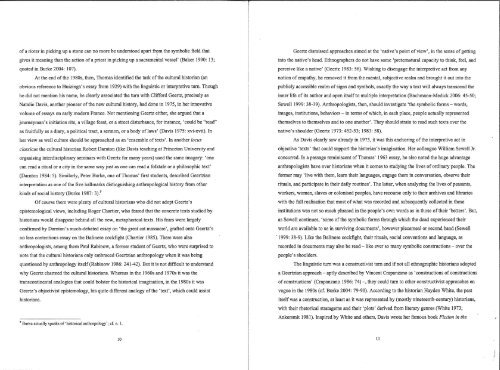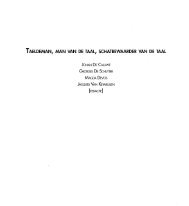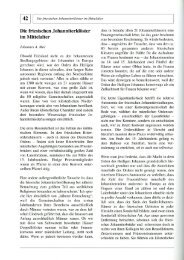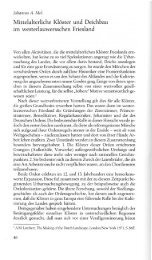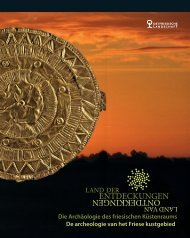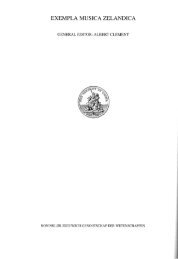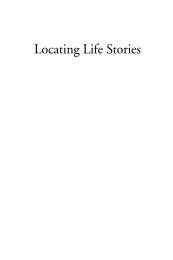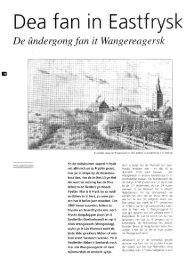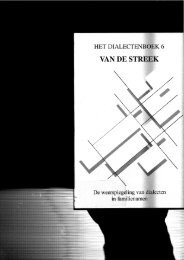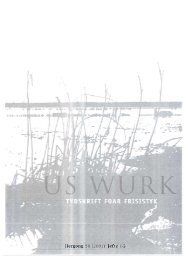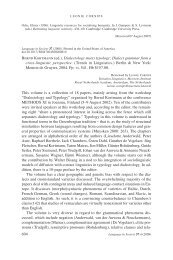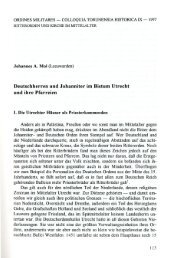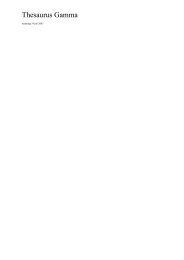Antropologen, historici en de hartslag van het archief
Antropologen, historici en de hartslag van het archief
Antropologen, historici en de hartslag van het archief
You also want an ePaper? Increase the reach of your titles
YUMPU automatically turns print PDFs into web optimized ePapers that Google loves.
of a rioter in picking up a stone can no more be un<strong>de</strong>rstood apart fr?m the symbolic field that<br />
gives it meaning than the action of a priest in picking up a sacram<strong>en</strong>tal vessel' (Baker 1990: 13;<br />
quoted in Burke 2004: 107).<br />
At the <strong>en</strong>d of the 1980s, th<strong>en</strong>, Thomas id<strong>en</strong>tified the task of the cultural historian (an<br />
obvious refer<strong>en</strong>ce to Huizinga's essay from 1929) with the linguistic or interpretive turn. Though<br />
he did not m<strong>en</strong>tion his name, he clearly associated the turn with Clifford Geertz, precisely as<br />
Natalie Davis, another pioneer of the new cultural history, had done in 1975, in her innovative<br />
volurne of essays on early mo<strong>de</strong>m France. Not m<strong>en</strong>tioning Geertz either, she argued that a<br />
journeyman's initiation rite, a village feast, or a street disturbance, for instance, 'could be "read"<br />
as fruitfully as a diary, a political tract, a sermon, or a body oflaws' (Davis 1975: xvi-xvii). In<br />
her view as well culture should be approached as an '<strong>en</strong>semble of texts' . In another locus<br />
classicus the cultural historian Robert Damton (like Davis teaching at Princeton University and<br />
organising interdisciplinary seminars with Geertz for many years) used the same imagery: 'one<br />
can read a ritual or a city in the same way just as one can read a folktale or a philosophic text'<br />
(Damton 1984: 5). Similarly, Peter Burke, one of Thomas , first stud<strong>en</strong>ts, <strong>de</strong>scribed Geertzian<br />
interpretation as one of the five hallmarks distinguishing anthropological history from other<br />
kinds of social history (Burke 1987: 3).9<br />
Of course there were pl<strong>en</strong>ty of cultural historians who did not adopt Geertz's<br />
epistemological views, including Roger Chartier, who feared that the concrete texts studied by<br />
historians would disappear behind all the new, metaphorical texts. His fears were largely<br />
confirmed by Damton's much-<strong>de</strong>bated essay on 'the great cat massacre', grafted onto Geertz's<br />
no less cont<strong>en</strong>tious essay on the Balinese cockfight (Chartier 1985). There were also<br />
anthropologists, among them Paul Rabinow, a former stud<strong>en</strong>t of Geertz, who were surprised to<br />
note that the cultural historians only embraced Geertzian anthropology wh<strong>en</strong> it was being<br />
questioned by anthropology itself (Rabinow 1986: 241-42). But it is not difficult to un<strong>de</strong>rstand<br />
why Geertz charmed the cultural historians. Whereas in the 1960s and 1970s it was the<br />
transcontin<strong>en</strong>tal analogies that could bolster the historical imagination, in the 1980s it was<br />
Geertz's objectivist epistemology, his quite differ<strong>en</strong>t analogy of the 'text', which could assist<br />
historians.<br />
9 Burke actually speaks of 'historical anthropology'; cf. n. 1.<br />
10<br />
Geertz dismissed approaches aimed at the 'native's point of view' ,in the s<strong>en</strong>se of getting<br />
into the native's head. Ethnographers do not have some 'preternatural capacity to think, feel, and<br />
perceive like a native' (Geertz 1983: 56). Wishing to dis<strong>en</strong>gage the interpretive act from any<br />
notion of empathy, he removed it from the m<strong>en</strong>tal, subjective realm and brought it out into the<br />
publicly accessible realm of signs and symbols, exactly the way a text will always transc<strong>en</strong>d the<br />
inner life of its author and op<strong>en</strong> itself to multiple interpretation (Bachmann-Medick 2006: 45-50;<br />
Sewell 1999: 38-39). Anthropologists, th<strong>en</strong>, should investigate 'the symbolic forms - words,<br />
images, institutions, behaviors - in terms of which, in each place, people actually repres<strong>en</strong>ted<br />
themselves to themselves and to one another'. They should strain to read such texts over the<br />
native's shoul<strong>de</strong>r (Geertz 1973: 452-53; 1983: 58).<br />
As Davis clearly saw already in 1975, it was this anchoring of the interpretive act in<br />
objective 'texts' that could support the historian's imagination. Her colleague William Sewell Jr.<br />
concurred. In a passage reminisc<strong>en</strong>t of Thomas' 1963 essay, he also noted the huge ad<strong>van</strong>tage<br />
anthropologists have over historians wh<strong>en</strong> it comes to studying the lives of ordinary people. The<br />
former may 'live with them, learn their languages, <strong>en</strong>gage them in conversation, observe their<br />
rituals, and participate in their daily routines'. The latter, wh<strong>en</strong> analyzing the lives of peasants,<br />
workers, wom<strong>en</strong>, slaves or colonised peoples, have recourse only to their archives and libraries<br />
with the full realisation that most of what was recor<strong>de</strong>d and subsequ<strong>en</strong>tly collected in these<br />
institutions was not so much phrased in the people's own words as in those of their 'betters'. But,<br />
as Sewell continues, 'some of the symbolic forms through which the <strong>de</strong>ad experi<strong>en</strong>ced their<br />
world are available to us in surviving docum<strong>en</strong>ts', however piecemeal or second hand (Sewell<br />
'1999: 38-9). Like the Balinese cockfight, their rituals, social conv<strong>en</strong>tions and language, as<br />
recor<strong>de</strong>d in docum<strong>en</strong>ts may also be read -like ever so many symbolic constmctions - over the<br />
people's shoul<strong>de</strong>rs.<br />
The linguistic tum was a constructivist tum and ifnot all ethnographic historians adopted<br />
a Geertzian approach - aptly <strong>de</strong>scribed by Vinc<strong>en</strong>t Crapanzano as 'constructions of constructions<br />
of constmctions' (Crapanzano 1986: 74) -, they could turn to other constructivist approaches <strong>en</strong><br />
vogue in the 1980s (cf. Burke 2004: 79-90). According to the historian Hayd<strong>en</strong> White, the past<br />
itself was a construction, at least as it was repres<strong>en</strong>ted by (mostly ninete<strong>en</strong>th-c<strong>en</strong>tury) historians,<br />
with their r<strong>het</strong>orical stratagems and their 'plots' <strong>de</strong>rived from literary g<strong>en</strong>res (White 1973;<br />
Ankersmit 1981). Inspired by White and others, Davis wrote her famous book Fiction in the<br />
11


